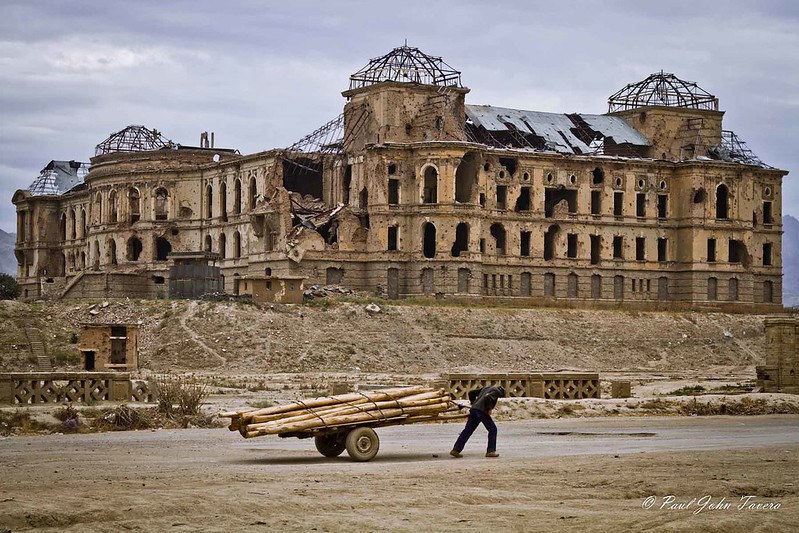Afghanistan may be no bigger than the US state of Texas, but despite its size, this ancient, land-locked country is home to an incredible array of landmarks. The country have has a unique combination of diverse and distinctive geography and a historically important position at the crossroads of several different cultures.
As a result, Afghanistan boasts some of the world’s most fascinating sites, from natural wonders to historic monuments to culturally significant places. Read on to take a tour of some of Afghanistan’s many amazing landmarks, famous and lesser-known alike.
1. The Blue Mosque
It’s not surprising that the Blue Mosque, located in Mazar-i-Sharif in northern Afghanistan, is one of the country’s best-known landmarks. The structure is simply breathtaking, often cited by experts as one of the world’s most stunning examples of classical Islamic architecture.

The Blue Mosque is a large complex, about 22,000 square feet in area, that is home to a large prayer hall, a small museum, a courtyard, and a number of holy tombs. Its name comes from the hundreds of thousands of gorgeous, intricate tiles covering nearly every inch of the building.
2. The Herat Citadel
Located in western Afghanistan, Herat is one of the country’s most beautiful cities. The citadel at its heart is nothing short of spectacular. Dating back to approximately 330 BCE, the Herat Citadel was originally built by Alexander the Great when he arrived in Afghanistan with his army.
Over the centuries, it has undergone repeated destruction and rebuilding. Much of the present structure, which includes 18 towers over 30 meters high, connected by walls two meters thick, was built in the 1400s. Today, after extensive rehabilitation efforts supported by UNESCO and other international organizations, the citadel is home to the National Museum of Herat.
3. The Hazarchishma Natural Bridge
The fact that Afghanistan has a great deal of remote, difficult-to-access territory means that some of its most amazing landmarks have only been discovered fairly recently. Such was the case with the Hazarchishma Natural Bridge, a colossal natural stone arch located in the central highlands of the country, nearly 10,000 feet above sea level.
Carved over millennia by the waters that once flowed through the now dry Jawzari Canyon, the natural bridge has a total span at its base of just over 210 feet, making it the world’s 12th-largest such formation. It was discovered in late 2010 by members of the Wildlife Conservation Society, who were conducting a wildlife survey in the area.
4. The Haji Piyada Mosque (Noh Gumbad)
Northern Afghanistan’s Haji Piyada Mosque measures a mere 20 by 20 meters, but its historic and cultural significance far surpasses its size. This is because the Haji Piyada Mosque is Afghanistan’s oldest known Islamic building, as well as one of the earliest surviving structures found anywhere in the eastern Islamic world. The mosque was built in the latter half of the ninth century, just after the arrival of Islam in Central Asia and only two centuries after the religion was first established.
Its alternate name, Noh Gumbad, comes from the nine cupolas that once covered the architecturally rich religious structure. No other similar buildings from this era are believed to have survived into the present day, a fact which endows the mosque with enormous cultural and architectural importance.
5. Basawal cave temples
The Haji Piyada Mosque may hold the distinction of being Afghanistan’s oldest Islamic structure, but long before Islam came to Afghanistan, the area was home to many different cultures, including a thriving Buddhist civilization. One of the most fascinating landmarks to have survived from this era is the Basawal cave temple complex in eastern Afghanistan.
Hewn directly into the region’s rocky territory, the complex consists of seven groups of cave temples that encompass roughly 150 caves. Exploration of the area has revealed that the caves originally served different purposes, from dwellings to places of worship.
6. Darul Aman Palace
An example of a fascinating landmark from Afghanistan’s more recent history is the Darul Aman Palace. This structure sits opposite the Afghan Parliament about 10 miles southwest of the city center of Kabul.

Constructed in the early 1920s during the reign of King Amanullah Khan, the palace was to be a symbol of a modern, hopeful future for Afghanistan. In fact, the name Darul Aman means “dwelling place of peace.”
The palace fell into disrepair during Afghanistan’s conflict years and then spent spent decades in ruins. In recent years, the palace has undergone extensive renovations and refurbishments to mark Afghanistan’s 100th year of independence in 2019.
7. Band-e-Amir
Afghanistan may not be the first place that comes to mind when thinking of countries with impressive national parks. However, Band-e-Amir, Afghanistan’s first ever national park, may soon change that.
Designated as a national park in 2009, Band-e-Amir is a stunning system of six sapphire-blue travertine lakes located high up in the Hindu Kush mountain range. The area has long been popular with tourists. Afghanistan is hopeful that the national park designation will help even more people, locals and visitors alike, discover the area’s amazing natural beauty.

